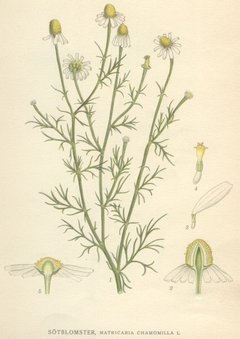German Chamomile
|
|
| German chamomile | ||||||||||||||
|---|---|---|---|---|---|---|---|---|---|---|---|---|---|---|
| Missing image Chamomile_flowers.jpg Chamomile Flowers | ||||||||||||||
| Scientific classification | ||||||||||||||
|
German Chamomile (Matricaria recutita) is an annual plant of the sunflower family Asteraceae. Synonyms are : Chamomilla chamomilla, Chamomilla recutita (accepted name according to the Flora Europaea), Matricaria chamomilla, and Matricaria suaveolens.
It usually grows near people all over Europe and temperate Asia. It is widely introduced in temperate North America and Australia. As the seeds need open soil to survive, it often grows near roads, around landfills and in cultivated fields as a weed.
Other names include Wild Chamomile and Scented Mayweed.
The branched stem is erect and smooth and grows to a height of 15-60 cm. The long and narrow leaves are bipinnate or tripinnate.
The flowers are borne in paniculate capitula. The white ray florets are furnished with a ligule, while the disc florets are yellow. The hollow receptacle is swollen and lacks scales. This property distinguished German Chamomile from Corn Chamomile (Anthemis arvensis), which has a receptacle with scales. The flowers bloom in June and July.
The flowers have a strong, aromatic smell. German chamomile is used medicinally against sore stomach and as a relaxant to help you fall asleep. It is best taken as a herbal tea, two teaspoons of dried flower per cup of tea. Against sore stomach take one cup every morning without food for 2-3 months. It is also used as a mouthwash against oral mucositis.[Juneby's Medicinal Plants]. It has also acaricidal properties against certains mites, such as Psoroptes cuniculi.
Chamomile is also used cosmetically, primarily to make a rinse for blonde hair.
Template:Commonsde:Kamille fi:Kamomillasainio nl:Echte kamille sv:Kamomill pl:Rumianek pospolity he:בבונג fr:camomille

